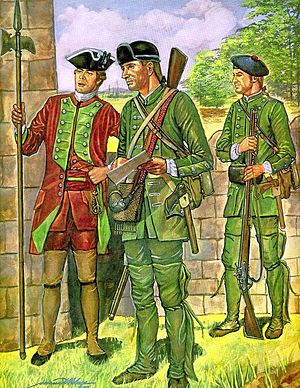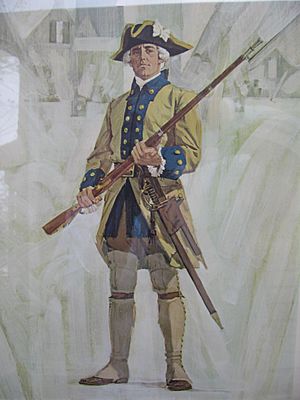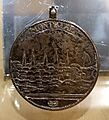Montreal Campaign facts for kids
Quick facts for kids Montreal Campaign |
|||||||
|---|---|---|---|---|---|---|---|
| Part of the French and Indian War | |||||||
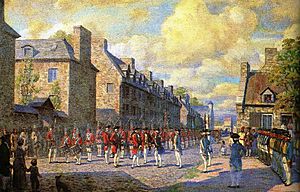 Surrender of the French Army in Montreal in 1760 |
|||||||
|
|||||||
| Belligerents | |||||||
| Commanders and leaders | |||||||
| Strength | |||||||
| 11,000 regulars, 6,500 provincials, 700 Iroquois |
3,200 regulars and Marines, Unknown militia, unknown natives |
||||||
| Casualties and losses | |||||||
| Light | 2,200 surrendered, 1,000 sick or missing. Militia and natives pacified |
||||||
The Montreal Campaign was a major event in the French and Indian War. It happened from July to September 1760. The British army launched a huge attack on Montreal, which was the last big city held by the French in New France.
The British forces, led by General Jeffery Amherst, had about 18,000 soldiers. They moved towards Montreal from three different directions. One group came from Lake Ontario, another from Québec, and a third from Fort Crown Point.
The French army was much smaller and had fewer supplies. Many French-Canadian soldiers left their posts or gave up their weapons. Even the Native allies of the French started making peace with the British.
The French military leader, Chevalier de Lévis, wanted to fight to the very end. But the governor of New France, Marquis de Vaudreuil, convinced him to surrender. The British demanded an unconditional surrender. On September 8, 1760, the French finally gave up. This victory meant the British had taken control of all of New France.
Contents
Why the Montreal Campaign Happened
After the fall of Quebec in 1759, French forces moved west. They went to Montreal. British forces held Quebec during the winter. They waited for spring to get more supplies and soldiers.
In April 1760, Chevalier de Lévis tried to take Quebec back. He won the Battle of Sainte-Foy. Then he besieged the city. But British ships arrived first with help. Lévis had to stop the siege and retreat.
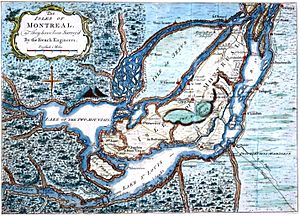
Lévis and Governor Vaudreuil met in Montreal. They wanted to defend their colony. Lévis hoped for help from a French fleet. But the British navy stopped this fleet. Many French ships were captured.
The British commanders wanted to end the war quickly. They planned to capture Montreal. It was the last major French stronghold. General Amherst led this plan. He gathered his large army for a final victory.
Planning the Attack on Montreal
In the winter of 1759–1760, British forces set up a base at Oswego. They built a small fleet there. This fleet would carry soldiers down the Saint Lawrence River to Montreal.
General Amherst planned a three-part attack.
- Amherst's main force had over 10,000 men. They would move east from Lake Ontario. Their goal was to cut off any French retreat.
- William Haviland led 3,500 men. They would advance from Fort Crown Point in New York. They would use Lake Champlain and the Richelieu River. This route had strong French defenses.
- James Murray led 4,000 men from Quebec. They would move west along the Saint Lawrence River. They would approach Montreal from the east.
In total, Amherst had about 18,000 men. About 11,000 were regular soldiers. The rest were provincial soldiers and Iroquois warriors.
Rogers' Rangers Raid
Amherst sent Robert Rogers and his Rangers on a special mission. They were to attack French supply depots. These were at Forts Chambly and Saint-Jean.
The raid began on June 3. Rogers found the forts too strong to attack directly. Instead, they surprised and burned the main supply depot at Sainte-Thérèse.
This raid was a big success. The British captured over 100 French soldiers. They also gained important information about French defenses. The raid shocked the French population. Many French-Canadian soldiers left the army. Native allies also started to abandon the French.
Lévis tried to keep morale high. But his army was shrinking. He had only 3,200 regular soldiers. Many of his Native allies were leaving. The French could not rely on their militia either. Most were tired of fighting and ready to surrender.
Lévis ordered Captain Pierre Pouchot to delay Amherst's army. Pouchot set up defenses at Fort Lévis. Other French forces guarded the Richelieu River.
The Campaign Begins
Murray's Advance from Quebec
James Murray's force of 4,000 men left Quebec on July 13. Some marched along the riverbank. The rest traveled on armed ships and boats. These boats carried heavy guns and supplies.
Murray's journey upriver was slow. French soldiers tried to stop them. But they did not cause much delay. Murray's ships attacked French defenses at Deschambault. They also captured Grondines.
Murray worked to make peace with the French-Canadian people. He spoke French and offered gold and silver coins. The French military had spread false rumors about British cruelty. But this backfired. Many Canadians chose to surrender to Murray. They swore loyalty to King George II.
By mid-August, Murray reached Trois-Rivières. He managed to bypass the French defenses there. On August 21, his Rangers found French forces near Sorel. Murray attacked them at night. The French were scattered, and the town was burned. Many Canadians abandoned the French cause.
By August 26, Murray's force was close to Montreal. Native leaders, including the Huron, came to make peace. Murray could not sign a formal treaty. But he promised to protect their rights.
The last French defense was at Varennes. British troops landed there on August 31. After a short fight, the town was secured. A French counterattack was stopped. The British had very few losses.
Murray's army continued to advance. They disarmed about 4,000 Canadians. These Canadians then swore loyalty to the British King. Murray's success meant the French lost many of their militia.
Amherst's Advance from Lake Ontario
Amherst's force left Oswego on August 10. They were joined by William Johnson and 700 Native warriors. British naval vessels went ahead.
On August 17, the ships reached Fort Lévis. They bombarded the island. After three days, the French commander, Pouchot, ran out of ammunition. He surrendered to Amherst on August 24.
Many Native warriors wanted to plunder Fort Lévis. Amherst refused this. Most of them went home. About 170 stayed with Amherst.
Johnson helped turn French-allied Natives. They agreed to stay neutral. Lévis tried to get his Native allies to help. But they left his conference. About 800 French-allied warriors were disarmed. Some even joined the British.
On August 31, Amherst left Fort Lévis. He renamed it Fort William Augustus. He continued down the Saint Lawrence River. The biggest challenge was the dangerous rapids. Many boats were wrecked. Some men drowned.
On September 4, the fleet reached the most dangerous rapids. Many boats were lost. 46 boats were totally wrecked. 84 men drowned. But they made it through. They landed at Île Perrot, about 35 km from Montreal.
Lévis ordered all French troops west of Montreal to retreat. They went to the Island of Montréal. Amherst repaired his boats. Then his troops continued their march.
Haviland's Advance from Crown Point
William Haviland's force of 3,500 men left Crown Point. They moved along the Richelieu River. Their path was blocked by Île aux Noix. This was a French position led by Louis Antoine de Bougainville.
On August 23, British cannons fired on Île aux Noix. Haviland sent Rangers and Native forces. They dragged three cannons through the forest. They placed them behind Bougainville's position. The French did not expect this.
The Rangers' cannons opened fire on French ships. One ship, the Waggon, was captured. Other French vessels tried to escape. But they got stuck. The Rangers swam out and captured them.
With the French ships gone, the British attacked the fort. They captured it and 50 French prisoners. Bougainville evacuated the island. He went to Fort Saint-Jean.
The French abandoned Fort Saint-Jean. They set it on fire. Rogers' Rangers found the burning ruins. They captured some French stragglers.
A British detachment joined Rogers. They came to Fort Chambly. The French commander, Paul-Louis Dazemard de Lusignan, refused to surrender. British guns fired for twenty minutes. Then Lusignan surrendered with 71 men.
Bougainville ordered all French forces to Montreal. But many soldiers were deserting. Haviland's force rested for two days. Then they marched towards Montreal.
Montreal Under Siege
On September 6, Amherst's army landed at Lachine. They marched towards Montreal. The French army retreated inside the city walls. Most Canadians had deserted. The French had less than 2,200 regular troops left. Many of these were sick or wounded.
Montreal was a city of wooden and stone houses. It had a shallow moat and stone walls. These walls were built to defend against Native attacks. They could not stop cannons.
On September 7, Amherst set up his siege guns. Murray's army landed and camped near Amherst. Haviland's force also arrived. The three British armies had surrounded Montreal. They had arrived almost at the same time.
The city was full of people who were not fighting. Governor Vaudreuil called a meeting. They decided that further resistance was impossible. So many soldiers had left. The Native allies had joined the British.
Lévis sent his second-in-command to ask for a ceasefire. He wanted a month's break. Amherst refused. He gave the French six hours to decide. Vaudreuil then presented 55 articles of surrender. The officers approved them.
The Surrender of Montreal
On September 7, Bougainville brought the surrender terms to Amherst. Amherst agreed to most terms. But he refused one important request. The French officers wanted to march out with their weapons and military honors.
Amherst replied, "The whole garrison of Montréal and all other French troops in Canada must lay down their arms, and shall not serve during the present war." He was very firm. He said he was punishing them for their actions. He believed they had encouraged Native allies to be cruel.
Lévis tried to change Amherst's mind. But Amherst would not budge. Despite Lévis's protests, the surrender was signed.
The surrender happened on September 8 at 8 AM. It was signed in a house near Montreal's walls. This surrender meant Canada and all its lands became British. French officers and soldiers were sent back to France.
The people of the colony were allowed to practice their religion freely. They could keep their property. Anyone who wanted to move to France could do so. Canadians kept their property rights, including slaves.
That evening, Lévis ordered his battalions to burn their flags. The next morning, British soldiers entered Montreal. They took positions in the main square. French battalions, totaling 2,200 men, laid down their arms. The British took control of all posts in Montreal.
What Happened Next
The British victory at Montreal ended the war in Canada. Amherst had won. He decided not to attack the French in Louisiana. The last campaign was the British advance to Michigan territory. Rogers' Rangers captured Fort Detroit in November.
Amherst gave silver medals to the Native allies who helped him. After the French defeat, their Native allies made peace with the British. This was the Treaty of Kahnawake in October. It allowed them to trade freely between Canada and New York.
French prisoners were sent to Quebec. Then British ships took them to France. British provincial soldiers went home. Montreal was garrisoned for the winter. By October 22, almost all French soldiers had left.
News of Montreal's capture made people in Great Britain happy. Songs were written about Amherst. He was seen as a hero. Artworks were created to celebrate the victory. One famous painting was "The Surrender of Montreal."
The Anglo-Cherokee War ended the next year. The British offered fair terms to the French Canadians. These terms were later made law. They were included in the Proclamation of 1763 and the Quebec Act. French-speaking people were protected. They could keep their property and religion. They could also move to France if they wished.
The war in North America was over. The fighting moved to the Caribbean. Spain joined France but was quickly defeated. The loss of Montreal was a huge blow to France. They could not get Canada back. The Treaty of Paris in 1763 officially gave Canada to Great Britain.
Thomas Gage became the first British Governor of Montreal. He kept many parts of the old French government system.
Images for kids
-
Surrender of Montreal to General Amherst by Francis Hayman








